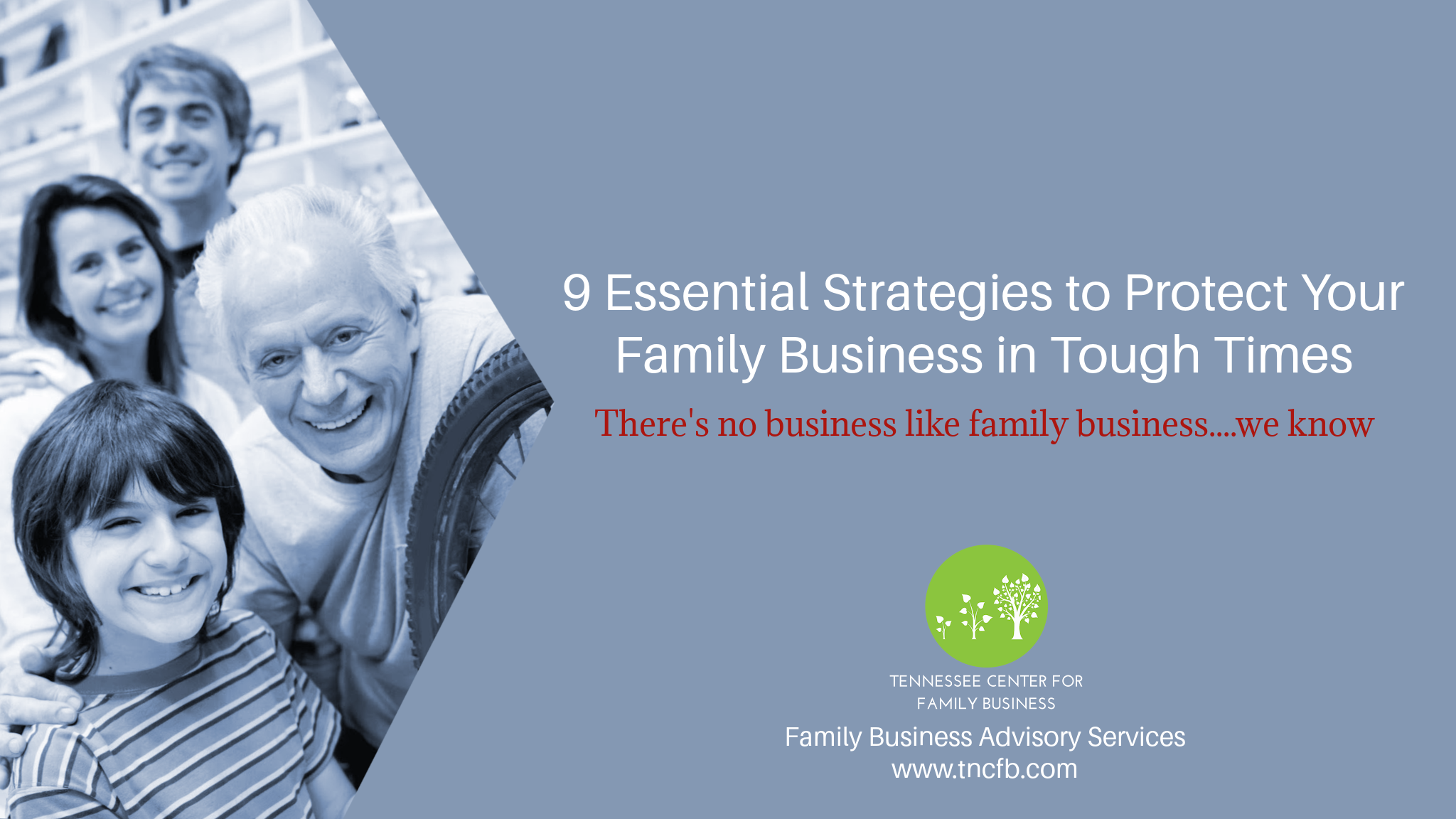I've spent time with a lot of family business leaders this year, and many of them are carrying both financial and emotional burdens as the economy keeps tightening. All businesses feel the strain in a downturn, but family businesses often feel it a little more. The mix of personal relationships and business responsibilities creates pressures that can tug at both operations and family ties. When emotions run high, decision making can get complicated, which is why it’s so important to face challenges with a clear plan and a sense of unity. By naming these dynamics and working with them instead of against them, family businesses can move through tough seasons and come out stronger. In today’s blog, we’ll walk through nine essential strategies you can use to protect both your business and your family relationships during challenging times.
Acknowledging Unique Pressures
In an economic downturn, the pressure on a family business isn’t just about money. There’s also the emotional investment that every member brings to the table. When people care deeply about the business, the stress of uncertainty can hit harder and spark conflict faster. Acknowledging these added pressures is the first step in building a supportive environment where folks feel safe being open and honest. When family members recognize what each person is carrying, it’s easier to communicate well, collaborate effectively, and pull together instead of drifting apart.
Importance of Proactive Business Strategies
Building resilience starts long before a crisis hits. For family businesses, adopting proactive strategies is essential. This means preparing for potential financial challenges, staying alert to opportunities for growth, and being willing to adapt when needed. When everyone in the family is aligned around the same goals, it strengthens the business and makes it easier to navigate uncertainty. A culture of teamwork and shared purpose creates a solid foundation that can support the business through economic ups and downs.
Introducing Nine Essential Strategies
To help guide family businesses through uncertain seasons, we’ll outline nine essential strategies that can serve as a practical roadmap for stability and long-term success. These strategies cover key areas of business management, including financial planning, risk management, customer relationships, and market shifts. By putting these tools into practice, family businesses can not only weather the challenges of an economic downturn but also set themselves up to thrive in the years ahead.
Strengthening Your Financial Core and Prudent Resource Management
When the economy gets rough, family businesses have to pay close attention to their financial footing. Strengthening your financial core isn’t just about cutting back; it’s about being intentional with the resources you have so your business can stay steady without losing sight of its values. With a few thoughtful steps, you can protect the health of your business while staying true to what makes it special.
Implementing Thoughtful Cost-Cutting Measures
Cutting costs doesn’t have to mean cutting corners. Instead of slashing everything in sight, take a close look at what truly matters to your business. Spend time reviewing your expenses and pinpointing areas where you can save without weakening the quality of your work. You might renegotiate contracts with suppliers or look for vendors who can offer the same reliability at a better rate. Approaching cost-cutting this way helps protect your finances while keeping your standards right where they belong.
Developing Robust Financial Planning Scenarios
Solid financial planning is one of the best tools you have during uncertain times. Building out cash flow projections for different economic situations gives you a clearer picture of what to expect and how to prepare. Setting aside contingency funds offers extra breathing room when challenges pop up unexpectedly. Make a habit of revisiting and updating your financial plans so you can stay ready for whatever comes your way and adjust before issues become roadblocks.
Exploring Options for Financial Support and Managing Debt Responsibly
When the economy tightens, looking into financial support can make all the difference. Loans, grants, or other assistance programs may help keep things moving, as long as they fit your long-term goals. Just remember to keep a close eye on your debt. Prioritize paying down high-interest balances and avoid taking on obligations that don’t serve your business’s future. Smart, responsible debt management strengthens your financial position and helps ensure your business stays on solid ground.
Building Operational Steadfastness and Thoughtful Risk Management
When the economy feels unpredictable, family businesses have to stay steady on their feet. Focusing on operational strength and smart risk management helps your business stay grounded, even when the road gets bumpy. By taking time to understand where your vulnerabilities are and putting solid plans in place, you give your business a better shot at handling whatever comes its way. This section walks through key strategies to help reinforce your operations and prepare for unexpected disruptions.
Identifying Potential Risks and Developing a Comprehensive Risk Management Framework
Every family business has its own set of risks, whether they come from shifts in the market or challenges within the family itself. That’s why it’s so important to step back and honestly assess where those risks might be. Once you’ve identified them, building a clear risk management framework can help you stay ahead of potential trouble. This framework should spell out how you’ll monitor risks, evaluate their impact, and put preventive measures in place. And since the landscape is always changing, revisiting and updating this plan on a regular basis keeps your business ready for whatever comes next.
Creating a Clear Business Continuity Plan
A strong business continuity plan can make all the difference when life throws you a curveball. This plan should map out which parts of the business are essential, what resources those areas depend on, and who is responsible for what during a disruption. Preparing for a range of scenarios, from severe weather to financial downturns, helps you keep operations moving and protect what you’ve built. Running occasional drills and holding training sessions ensures everyone knows their role so the team can step into action without hesitation when challenges arise.
Fostering a Culture of Preparedness and Adaptability
Resilience isn’t only about plans on paper, it involves the mindset of the people behind the business. Encouraging open conversations about risks and involving your team in finding solutions builds a culture of preparedness. When folks feel comfortable sharing concerns and suggesting new ideas, adaptability becomes part of your everyday operations. Offering regular workshops and training can help strengthen these values, giving your team the confidence and skills to tackle uncertainties head-on.
Thoughtful Market Adaptation and Cultivating Customer Loyalty
When the economy gets uncertain, family businesses do well to focus on adapting to the market and strengthening customer loyalty. Paying attention to what customers are saying — and watching how the market is shifting! — helps you shape strategies that meet today’s needs while keeping an eye on what’s coming next.
Actively Listening to Customer Feedback
Knowing what your customers want is the foundation of staying relevant, especially in tough times. Make a point to ask for their feedback and genuinely take it to heart. Whether it’s through surveys, small focus groups, or casual conversations, customers are often happy to share what’s working and what could be improved. Their input can guide meaningful tweaks to your products or services, helping you stay aligned with what your customers value most.
Nurturing Existing Relationships
Strong customer relationships are one of the greatest assets a family business can have. Keeping those connections healthy means consistently offering value and staying open in your communication; it’s about being approachable, transparent, and reliable. Simple gestures like regular updates, personalized outreach, or well-designed loyalty programs can make customers feel appreciated and keep them coming back.
Thoughtfully Refining Products or Services
As the market changes, your offerings may need to change with it. Taking a thoughtful approach to refining your products or services helps you stay competitive. This might mean adding useful features, reshaping a service, or revisiting your pricing strategy to better match customer expectations. Staying tuned in to both customer input and market trends ensures your business remains relevant and ready to meet shifting needs.
Exploring New Horizons and Embracing Sustainable Growth
As family businesses continue to evolve, looking ahead and exploring new opportunities becomes essential for long-term success. By branching out into new income streams, committing to sustainable practices, and encouraging innovation, family-owned companies can better handle challenges and make the most of emerging opportunities.
Diversifying Income Streams
One practical way for family businesses to stay steady is to consider new sources of income. Diversifying not only spreads out risk during economic ups and downs but also lets you lean into strengths that already exist within the business. For example, a family farm might branch into agritourism or develop value-added products that appeal to new customers. Exploring fresh markets like these helps build additional revenue streams that support both growth and stability.
Adopting Sustainable Practices
Sustainable practices play a big role in keeping a family business resilient. They’re good for the environment, and they also strengthen operations and build trust with customers and the community. A family-owned manufacturing company, for instance, might shift toward energy-efficient equipment or prioritize responsibly sourced materials. These kinds of decisions can lower costs over time and reinforce the business’s reputation with customers who care about sustainability.
Encouraging Innovation and Creative Problem-Solving
Innovation helps family businesses uncover new paths forward. When you encourage creative thinking within your team and family, you open the door to ideas that can move the business ahead in meaningful ways. Regular brainstorming sessions or workshops can spark solutions that feel both fresh and aligned with your mission. By supporting a culture that values creativity, your business can stay adaptable and ready to meet changing customer needs and market conditions.
The Enduring Strength of Family Unity and Forward-Looking Planning
When challenges arise, the strength of family unity and a forward-thinking mindset can carry a family business through even the toughest seasons. By keeping communication open and reconnecting with the values that brought the business to life in the first place, families can face uncertainty together and keep their business strong for generations to come.
Open and Honest Communication
Open, honest communication is one of the most helpful tools a family business can rely on. When family members feel safe sharing their thoughts and concerns, it builds trust and strengthens understanding across the board. Regular family meetings create space to talk through business challenges, exchange ideas, and work out solutions as a team. This kind of collaboration not only tightens family bonds but also improves decision making, helping the business stay adaptable and resilient when circumstances shift.
Reinforcing Shared Vision and Values
Revisiting your shared vision and values can provide steady guidance during difficult times. These principles shape how your family makes decisions and keep everyone aligned around common goals. Taking time to reflect on what your business stands for helps ensure you stay true to your mission, even when the pressure is high. This shared sense of purpose becomes especially important during economic downturns, reminding family members why they’re in this together and reinforcing the importance of supporting one another.
Thoughtful Future Planning
Thinking ahead with some good, solid planning is one of the best ways to make sure the family business stays a steady source of strength for years to come. It’s not only about keeping the books in order. You also need to really engage in succession planning so folks can spot and prepare the next generation of leaders. When everyone understands their roles and what’s expected of them, it gives the whole family a clearer path forward and keeps things running smooth. And when families take time to do a little strategic thinking, they’re better able to roll with the changes in the market, grab hold of new opportunities, and sidestep the bumps in the road.
At the Tennessee Center for Family Business our passion is to help families Thrive, their business Grow and working together create a Lasting Family Legacy. If your family business is dealing with unique challenges during these tough economic times, you are not alone. Contact us at info@tncfb.com to schedule a 30 minute, NO COST Call with a family business advisor.
To learn more, find other blog posts like this on our website at www.tncfb.com. You can also listen to our Family Business Today Podcast on Spotify, Apple Podcast or at our website. Meanwhile....
If you want to talk....we will listen.
















